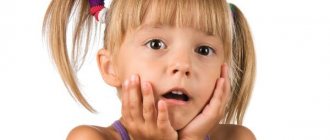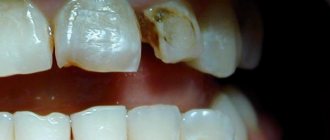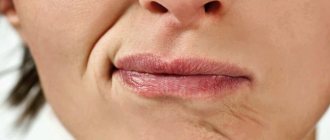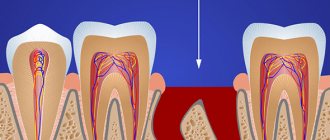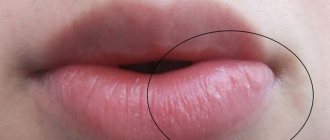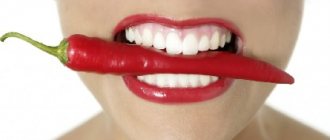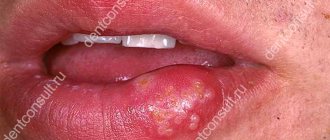The birth of a baby is always a joy for young parents. Naturally, all the attention of the mother and father is focused on the child. They can't get enough of how well he eats, sleeps and smiles back at them.
- Causes of lower lip tremor in babies
- Complications and consequences of tremor
- What measures should be taken if a baby’s lower lip is shaking?
But when the baby starts crying and the parents notice their lips trembling, they become alarmed. Therefore, we will look at why a newborn’s lower lip is shaking.
Causes of lower lip tremor in babies
Often mothers notice that their child’s lower lip shakes when the baby is at rest. And here the parents begin to panic. The thought immediately pops into their head that their little one is seriously ill with something.
Tremor is a shaking associated with involuntary contraction of the mental, triangular and quadratus muscles of the lower lip. Now let's look at the reasons for the formation of tremors from the norm and pathology.
- Response to stimuli (cold, stress, loud sound, sudden influx of bright light).
- When a newborn is stressed, an uncontrolled amount of norepinephrine is released from the adrenal cortex, which enters the bloodstream. NA causes vasospasm and contraction of smooth muscle tissue.
- An underdeveloped central nervous system is unable to regulate the baby's movements.
Among the stressful situations why a newborn's lower lip shakes, one can highlight: bathing, intestinal colic (pain), the moment of changing clothes, a state of hunger, and ordinary fatigue.
- Involuntary muscle contraction at rest.
- Joint trembling of the chin and lower lip, limbs, head.
- Frequently recurring tremors.
- After three months of age, trembling becomes more frequent.
The causes of pathological tremor are:
- prematurity (in premature children, trembling is observed up to 1.5-2 years);
- stress during pregnancy;
- developmental disorder of the peripheral nervous system (PNS);
- increased ICP (intracranial pressure);
- increased blood sugar in a newborn;
- maternal diabetes mellitus or impaired glucose tolerance during pregnancy;
- birth trauma (long, protracted labor; injury received when the head passes through the birth canal);
- Polyhydramnios, infections during pregnancy and a deficiency of essential microelements and vitamins (in particular Mg and B vitamins) can cause disruption in the development of the central nervous system (hereinafter referred to as the CNS) of the fetus.
Child rolling his eyes: psychological or medical problem?
In most cases, the problem with eye rolling in a child has very specific causes (most often they are associated with disruption of the brain, but there may also be psychological reasons).
Symptoms and causes.
Rolling the eyes upward is normal for a newborn baby up to one month of age. Especially before bed, during the borderline state between sleep and wakefulness. But if a child rolls his eyes downward, you should pay attention to this and contact a pediatric neurologist. This phenomenon can occur for many reasons. The most common cause of eye rolling in newborns is increased intracranial pressure. The cause may also be nervous tics and Tourette's syndrome, obsessive-compulsive disorder, i.e. relieving the child's increased nervous tension through some repetitive action.
One of the common tics is associated with rolling the eyes, twitching the eyes, or briefly looking in the same specific direction. Epilepsy can also be manifested by eye rolling. Petite epileptic seizures - absence seizures - are often accompanied by rolling of the eyes and a short-term “freezing”, stopping all higher mental functions of the child. Those. the child stops, falls silent, freezes, rolls his eyes, and after a while he “turns on” and continues to act as if nothing had happened. This is a manifestation of epileptic absence seizures. A minor epileptic seizure can develop into a major one. In this case, the child first rolls his eyes, then twitches one or more muscles, and after this a full-blown convulsive attack occurs - this is a more severe manifestation of epilepsy.
Other options are also possible.
For example, a child may have pain in the eyes, eyeballs with various diseases associated with the nasopharynx and ears (adenoids, inflammation of the sinuses, tonsils, or inflammation of the ears), when pain occurs in the area of the facial skull and soft tissues of the face, pharynx. Who do you turn to when your child rolls their eyes?
In case of such symptoms, it is necessary to show the child to a pediatric neurologist and ophthalmologist, as well as an otolaryngologist if there are any specific problems. But first, we still recommend consulting a pediatric neurologist.
Complications and consequences of tremor
Physiological tremor does not pose any danger to the health of an infant. After 3-4 months after birth, trembling of the chin and lower lip disappears and no longer bothers either the child or his parents.
As for pathological tremor, here things are much more complicated. Prolonged and frequently recurring tremor is the first alarm bell indicating neuropathy. Involuntary contraction of the muscles of the chin, lips, upper and lower extremities, and head may indicate the presence of perinatal encephalopathy in the baby.
This pathology may include various disorders of the central nervous system that arise as a result of intrauterine development. If you consult a doctor in a timely manner, the disease can still be treated.
If the tremor of the lips and chin is not caused by neurology, then it is necessary to undergo a set of examinations to determine whether there is a deficiency of Ca and Mg in the baby’s body, and diabetes mellitus.
What measures should be taken if a baby’s lower lip is shaking?
Above we discussed why a newborn’s lower lip shakes. Now let’s look at how parents should act in such a situation. When a pathological tremor has been identified in an infant, a neurologist will treat it.
When an infant’s lower lip and chin shake under stress, you need to do the following:
- Do not panic and do not jump near the baby shouting “Oh!” and “Ay!” The baby needs to create a cozy and comfortable environment. Better yet, kiss the little one!
- Get rid of the cause of stress (turn off the music, turn off too bright lights).
- If you have the opportunity to breastfeed your baby, then you need to continue in the same spirit. No mixtures!
- Control your sleep patterns. Feeding, sleeping, and waking the child should take place at the scheduled time.
- Walk with your baby in the fresh air for at least 3 hours.
- Pay attention to the baby's clothing. It should not allow the child to overheat.
- Feel free to harden your baby by wiping him with a towel.
- Massage.
After visiting a neurologist, you may be prescribed a relaxing massage and sea salt baths. The massage procedure can be carried out either in a clinic with a massage therapist or at home.
The massage itself should not last more than 10 minutes.
Knowing all this, you shouldn't panic. If you are concerned about tremor of the baby's lower lip, contact your local pediatrician, who will prescribe an examination if necessary.
www.preobrazhenie.ru - Transfiguration Clinic - anonymous consultations, diagnosis and treatment of diseases of higher nervous activity.
- If you have questions for the consultant, ask him via a personal message or use the “ask a question” form on the pages of our website.
You can also contact us by phone:
- 8 495-632-00-65 Multichannel
- 8 800-200-01-09 Calls within Russia are free
Your question will not remain unanswered!
We were the first and remain the best!
CREATE NEW MESSAGE.
But you are an unauthorized user.
If you have registered previously, then “log in” (login form in the upper right part of the site). If this is your first time here, please register.
If you register, you will be able to further track responses to your messages and continue the dialogue on interesting topics with other users and consultants. In addition, registration will allow you to conduct private correspondence with consultants and other users of the site.
Any unusual behavior of a baby frightens young parents. When a newborn's lower lip trembles, they may panic. After all, he is so small and vulnerable. How to understand what is happening to him? The first thought that appears is that the child is cold. The mother takes the child in her arms and tries to warm him up. In the mother's arms, the baby often calms down, and his lips stop trembling. But there are times when a baby’s chin shakes in a warm room and in the mother’s arms. It is difficult for parents to find an explanation for this. This means that something is wrong with the baby and he is sick. Is this condition a sign of a disease?
Obsessive neuroses
In most cases, the problem of obsessive-compulsive neurosis and tics is solved by play psychotherapy or a course of medical treatment, and most often by a combination of drug treatment and psychological work with suppressed nervous tension in the child.
Obsessive neuroses in children manifest themselves in the form of obsessive movements and thoughts. Obsessive states (obsessions) manifest themselves as irresistible and involuntarily arising thoughts, fears, and, as a result, obsessive movements.
Intrusive thoughts
- when a child fears for the health and safety of himself and his family
- constantly thinks or imagines that something bad might happen to them
- always remembers negative events that happened to him or his family in the past
Typical obsessive mental actions
- reading license plates, signs, operations with numbers and letters from license plates and signs
- counting lamp posts, houses, lawn fences, etc.
- constant search for “favorite” and “unfavorite” letters and numbers
Obsessive movements and actions.
The scope of their manifestations is very extensive. This could be a nervous tic in a child, or obsessive movements. The most typical obsessive movements and actions in children:
- biting nails and lips
- hair pulling
- thumb sucking, sucking or biting a pencil, pen, button, edge of clothing
- coughing, grunting, or making noises
- twitching of limbs
- blinking and/or stereotypic eye movements
- circling
- tapping, clapping
- rocking
- squatting, limping when walking
- rubbing the body or objects
- shaking and shaking hands and objects
- jumping and skipping for no reason
- muscle contractions of the arms and legs, as well as the face.
Typical complex ritual actions
- Children can walk on certain floor tiles
- walk around, twist, stroke the object a certain number of times
- jump up and clap your hands, pronounce phrases, etc.
Also, neuroses can have a different course:
- episodic
- chronic
- progressive
Neurosis in a child can have different causes
. The most common is the presence of any mental trauma in the child, as well as the presence of emotional factors. Such as: a tense and conflictual situation in the family, incorrect and too harsh and authoritarian upbringing of children.
Often this list also includes physiological reasons: heredity and genetics, previous diseases, physical overload of the child, lack of sleep.
One way or another, all this is due to the fact that the child has increased arousal in certain areas of the brain. Basically we are talking about dysfunction of the subcortical nuclei of the brain, which are responsible for posture and facial expressions, muscle tone and global motor acts. The child is forced to somehow relieve this excitement. Thus, this discharge occurs precisely through actions.
These may be: tics (the child twitches or jerks with some part of the body), fast stereotypical movements, there may be obsessive postures, obsessive movements; the child may sit down, jump, make some sounds, pronounce words or even swear words (with Tourette syndrome). Very often such manifestations are not taken seriously in the initial stages.
Tourette's syndrome is a genetically determined condition associated with obsessive-compulsive disorder and tics, or stereotypical tic-like movements.
Also, neurosis-like obsessive states are largely provoked by chronic streptococcal infection with an increase in antistreptolysin O (ASLO) in chronic tonsillitis, the so-called PANDAS syndrome, ongoing neuroinflammation with an increase in markers such as NSE and S100 protein. We also often see such manifestations in children who are carriers of neuroinfections, that is, infections that have a toxic effect on the nervous system.
EEG (electroencephalography) for children at the Echinacea clinic
We advise you to contact a child neurologist, child psychiatrist and allergist-immunologist. For convenience and coordination of assistance to the child, we practice a consultation of all three specialists. Thanks to this, the appointments are more informative, and the effect of the prescribed therapy occurs faster.
Obsessive neurosis responds well to treatment in the early stages, especially in preschool age.
As for Tourette's syndrome, even if there is a genetic predisposition, this syndrome can become silent. After all, until the debut of Tourette syndrome, the child lives with the same genetic makeup, but there are no tics or vocalisms. This is not only a matter of genetic predisposition to Tourette's syndrome, but also related problems and the current state of the child's health. Working with provoking factors (obsessive-compulsive disorder, infections, concomitant inflammatory diseases, sleep disturbances, high levels of anxiety, etc.) usually leads to gradual improvement, often until the complete cessation of tics and vocalisms.
We widely practice play therapy for the treatment of obsessive neuroses in children
Physiological causes of chin tremors in infants
Trembling (tremor) of the chin is often observed in very tiny children. Typically, a newborn's lower lip will quiver when he is excited, cries a lot, is very upset, or is in pain. At this moment, his arms or legs may also tremble.
The cause of this condition is usually the imperfection of the baby’s nervous and endocrine systems. When he is scared or angry, his adrenal glands produce stress hormones - adrenaline and norepinephrine. The baby’s adrenal glands have not yet adjusted their work, so more hormones are produced than necessary. Excess hormones literally burn the baby's muscles, causing them to contract. But this condition passes quickly enough as soon as the baby calms down. Therefore, the tremor often disappears after the mother takes the child in her arms. The baby is calmed by contact with his mother's body.
Most children develop trembling of the chin or lips in the first months of life. It is considered normal for tremors to appear after prolonged crying, physical activity or emotional overexcitation. A baby may become overexcited after playing for a long time or due to a prolonged lack of sleep.
But why does a newborn's lip tremble when he is calm?
Prevention
The main preventive measures come down to pregnancy planning and preliminary treatment of diseases of the expectant mother. Together with giving up bad habits and a calm lifestyle, they help prevent lip shaking.
If a newborn exhibits a symptom, it is necessary to create an environment in which he will be protected from a surge of strong positive or negative emotions.
To do this you need:
- maintain a daily routine and take frequent walks;
- protect the child from bright lights and loud sounds;
- surround it with a cozy and calm atmosphere;
- continue breastfeeding, but do not apply to the breast when the mother is in an excited state;
- carry out preparations for walks and hygiene procedures calmly;
- Give your child a massage to relieve muscle hypertonicity.
If your newborn's lower lip or chin often shakes, massage will help calm him down and relieve tension.
Contact of the newborn's skin with the mother's skin, gentle stroking, carrying the baby in a kangaroo, soothing warm baths help reduce the severity of the symptom and reduce the newborn's reaction to irritants.
Muscle hypertonicity
Sometimes a baby's shaky chin appears even when he is calm. The cause of this phenomenon may be muscle hypertonicity. This is a limitation of the voluntary motor function of the infant, caused by certain disorders in the development of the brain and peripheral nerve. With hypertonicity, the baby's muscles are overstrained. They remain tense even when the baby is in a relaxed state.
Other signs of hypertonicity are poor quality sleep (the baby sleeps little and poorly), increased irritability, frequent regurgitation after feeding, throwing back the head and unnatural arching of the body.
If you suspect hypertonicity, you can conduct an experiment. You need to take the baby under the armpits and place him on a hard surface, slightly tilting him forward. In this position, babies begin to instinctively move their legs, as when walking. A baby with hypertonicity will stand on his toes, while a healthy baby will stand on his entire foot. This is a classic diagnostic sign of hypertension and dysfunction of the nervous system.
Other reasons
Muscle tremors often accompany in the first months of life those babies who suffered from oxygen starvation in the womb.
Oxygen starvation of the fetus is called hypoxia. It occurs when placental abruption, entanglement with the umbilical cord, in the event of a threat of miscarriage, or due to other disorders of placental blood flow. Fetal hypoxia can be caused by infectious diseases, polyhydramnios, or bleeding. Lack of oxygen affects brain development and causes tremors in children.
Chin trembling often affects children whose mothers were in a state of nervous tension during pregnancy. During pregnancy, a woman's body produces a lot of stress hormones. They penetrated the placenta and entered the baby’s blood. Maternal stress hormones could cause disturbances in the functioning of the child’s nervous and endocrine systems.
Diagnostics
To make a diagnosis, the pediatrician gets acquainted with information regarding the course of pregnancy and childbirth, evaluates the child’s reflexes, condition and physical development using the Apgar scale. He analyzes the clinical picture, if necessary, prescribes laboratory and instrumental diagnostic methods.
Laboratory techniques for identifying the causes of convulsive muscle contractions include the study of biochemical blood parameters. They make it possible to find out the content of calcium, sugar, magnesium, and organic phosphorus in the blood serum. With their help, hyperglycemia, hypocalcemia, and hypomagnesemia are confirmed or excluded.
You can donate blood for testing free of charge at a public medical institution at your place of residence. In paid clinics and private medical laboratories, the cost of tests varies.
Approximately it consists of:
- sugar 260 rub.;
- calcium 140 rub.;
- magnesium 160 rub.
Upon referral from a neurologist, depending on the condition of the newborn, several types of hardware diagnostic examinations are performed. Due to the policy of the medical center and different characteristics of the installed equipment, prices for the same service may differ up or down:
- Neurosonography . Through incompletely closed sutures of the skull or fontanel, tumors, hemorrhages and other anomalies are detected using ultrasound, and the condition of the brain is assessed. NSG is safe and does not require prior preparation. The procedure takes no more than 10 minutes. The cost of a brain ultrasound will cost 400-900 rubles.
- Electroencephalography . A cap with electrodes that are connected to an electroencephalograph is placed on the child’s head. The method allows you to make a graphical recording of the electrical activity of the brain. EEG makes it possible to give an indirect assessment of the maturity and activity of brain structures. The reception is harmless; it is advisable to carry out the examination while the child is sleeping, since in this case the results are most informative. The price of the service is in the range of 2700-11700 rubles.
- Magnetic resonance and computed tomography . MRI and CT scans create layer-by-layer photographs of all brain structures, spacing several millimeters between images. The relative safety of X-ray doses is compensated by the effectiveness of examinations. A CT scan is performed in a few minutes, an MRI takes 30 minutes, but is more informative. Typically, children under 1 year of age are examined using magnetic resonance imaging while they are asleep. Prices for CT start from 2150 rubles, for MRI from 2000 rubles.
- Electroneuromyography . Electrodes are connected to the child’s hand, muscle contractions are recorded using a myograph, and the speed of electrical impulses passing through the nerve fibers is determined. This method provides accurate information about the causes of increased nervous sensitivity, allows one to identify damage to one nerve or nerve plexuses, and assess the nature and severity of deviations from the norm. The study takes 30-60 minutes and does not require preparation. The cost and duration of the procedure depends on the area of examination. The average price for ENMG is within the range of 1210-6000 rubles.
Modern instrumental methods make it possible to clarify the cause of the pathological condition.
Conclusions upon completion of examinations do not qualify as diagnoses. Only a neurologist can prescribe studies based on strict indications, taking into account contraindications, and interpret their results.
